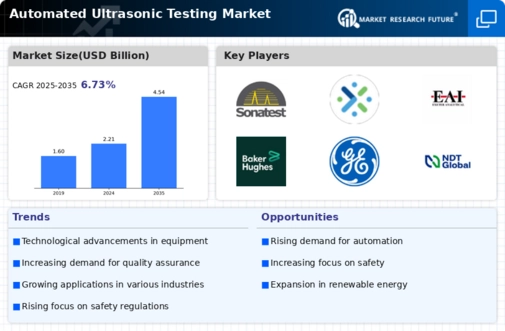Regulatory Compliance
Regulatory compliance is a critical driver for the Global Automated Ultrasonic Testing Market Industry, particularly in industries such as aerospace, automotive, and manufacturing. Governments worldwide are enforcing stringent regulations to ensure safety and quality standards, necessitating regular inspections of critical components. Automated ultrasonic testing serves as an effective solution to meet these compliance requirements, offering precise and reliable results. As industries adapt to these regulations, the demand for automated testing solutions is likely to increase. This shift is expected to bolster market growth, contributing to the anticipated rise from 2.21 USD Billion in 2024 to 4.54 USD Billion by 2035.
Market Growth Projections
The Global Automated Ultrasonic Testing Market Industry is projected to experience substantial growth over the next decade. With a market value of 2.21 USD Billion in 2024, it is anticipated to reach 4.54 USD Billion by 2035, reflecting a robust CAGR of 6.76% from 2025 to 2035. This growth is driven by various factors, including technological advancements, increased regulatory compliance, and rising investments in infrastructure. As industries continue to prioritize safety and efficiency, the demand for automated ultrasonic testing solutions is likely to expand, positioning the market for significant developments in the coming years.
Technological Advancements
The Global Automated Ultrasonic Testing Market Industry is experiencing rapid technological advancements that enhance the efficiency and accuracy of testing processes. Innovations such as phased array ultrasonic testing (PAUT) and time-of-flight diffraction (TOFD) are becoming increasingly prevalent. These technologies allow for more detailed inspections and quicker data analysis, which is crucial in sectors like aerospace and energy. The integration of artificial intelligence and machine learning further optimizes data interpretation, potentially reducing human error. As a result, the market is projected to grow from 2.21 USD Billion in 2024 to 4.54 USD Billion by 2035, indicating a robust demand for advanced testing solutions.
Growing Demand in Energy Sector
The Global Automated Ultrasonic Testing Market Industry is significantly driven by the increasing demand for reliable testing solutions in the energy sector. As the world shifts towards sustainable energy sources, the need for regular inspection of pipelines and other infrastructure becomes paramount. Automated ultrasonic testing provides a non-destructive method to ensure the integrity of these assets, thereby preventing costly failures and environmental hazards. The market is expected to expand as energy companies invest in advanced testing technologies to comply with stringent regulations. This trend is likely to contribute to the projected CAGR of 6.76% from 2025 to 2035, reflecting the sector's commitment to safety and efficiency.
Rising Awareness of Safety Standards
The Global Automated Ultrasonic Testing Market Industry is benefiting from a growing awareness of safety standards across various sectors. Industries are increasingly recognizing the importance of maintaining high safety and quality levels to protect both workers and consumers. Automated ultrasonic testing provides a reliable means of detecting flaws and ensuring the integrity of materials and structures. This heightened focus on safety is driving companies to invest in advanced testing technologies, thereby expanding the market. As organizations prioritize compliance with safety regulations, the demand for automated ultrasonic testing solutions is expected to rise, contributing to the overall growth of the industry.
Increased Investment in Infrastructure
The Global Automated Ultrasonic Testing Market Industry is poised for growth due to increased investments in infrastructure development globally. Governments and private sectors are allocating substantial funds to enhance transportation, energy, and communication networks. Automated ultrasonic testing plays a vital role in ensuring the structural integrity of these projects, from bridges to pipelines. As infrastructure projects expand, the need for effective testing solutions becomes more pronounced. This trend is likely to drive market growth, with projections indicating a rise from 2.21 USD Billion in 2024 to 4.54 USD Billion by 2035, reflecting the essential nature of these technologies in modern construction.











